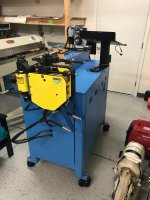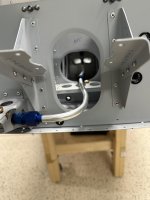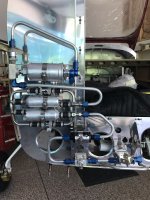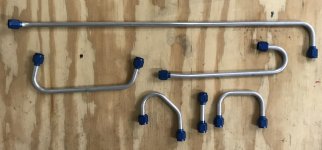FlyingDiver
Well Known Member
Just started work on page 27iS-04 (RV-12iS), fabricating the F-12127K fuel line. Step 3 is:
First, I can't do a bend that close to the end of the tube with the bending tool I have. I've ordered a smaller one, but in the meantime I can just add a couple inches when cutting the tube, do the bend, then cut off the excess. Then do the flare. Not the order in the plans, but should that matter?
Flaring that close to the bend is just barely doable with the flare tool, but I managed.
I cannot slide the AN819-6D sleeve over the bend, when I start from the opposite end. Even with the 38 degree bend. Never mind the 90 degree bend.
If I slide the sleeve on from the bent end, I can't slide it far enough down the tube to get the flare done. It's a very short straight end on the part.
I've now cut and attempted to fabricate this part 4 times. All wasted. Good thing I have another roll of the tubing on order.
I don't understand what I'm doing wrong. Any hints?
joe
Measure 21/32 in. [16.7 mm] from the tank end of the tube and mark the end of bend line. Measure 1 5/16 in. [33.3 mm] from the tank end of the tube and mark the start of bend line.
Flare the tank end of the tube.
Make the 38° bend by referencing Figure 2, View A-A. Place the nut and sleeve over the opposite end of the tube. Slide the sleeve against the flare.
First, I can't do a bend that close to the end of the tube with the bending tool I have. I've ordered a smaller one, but in the meantime I can just add a couple inches when cutting the tube, do the bend, then cut off the excess. Then do the flare. Not the order in the plans, but should that matter?
Flaring that close to the bend is just barely doable with the flare tool, but I managed.
I cannot slide the AN819-6D sleeve over the bend, when I start from the opposite end. Even with the 38 degree bend. Never mind the 90 degree bend.
If I slide the sleeve on from the bent end, I can't slide it far enough down the tube to get the flare done. It's a very short straight end on the part.
I've now cut and attempted to fabricate this part 4 times. All wasted. Good thing I have another roll of the tubing on order.
I don't understand what I'm doing wrong. Any hints?
joe








